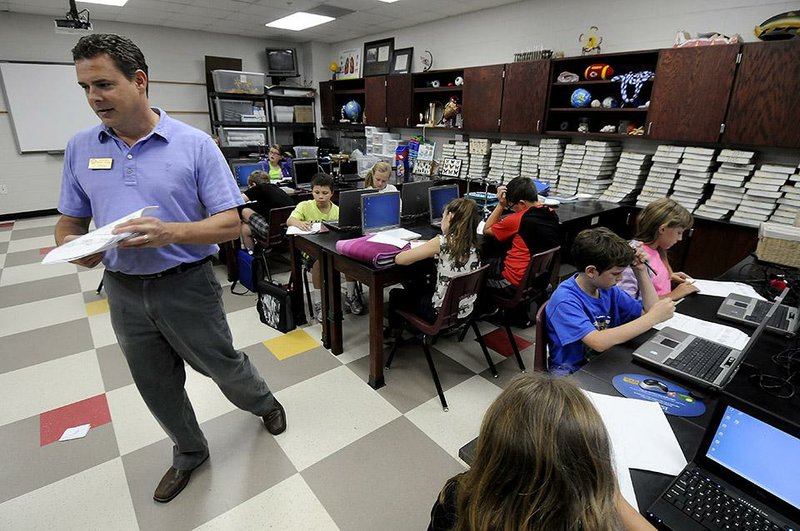Hellstern Middle School seventh-grade teacher Leigh Verucchi spent time this week talking with students in her advisory class about their ambitions.
Verucchi listened intently as Max Pena, 12, told her he wants to be a professional football player or soccer player. She told him that most professional athletes play in college and offered to help him in thinking about a college plan to help him reach his goal.
"At this point, they dream big," Verucchi said. "We're just starting to think about those things."
Other students said they want to be artists, doctors and teachers. One student is interested in animation, while another student wants to be a singer. Verucchi asked each student questions about what steps they must take to reach their goals and how much education they need.
All Springdale School District elementary and middle schools are implementing a new system this school year to give students more say in their education. The system involves advisory classes, development of personalized learning plans for each student and parent-teacher conferences that are led by students.
Personalizing education is a major focus for the district, which in December was named a recipient of a four-year $25.88 million Race to the Top grant for school districts by the U.S. Department of Education. The advisory program is one project supported by the grant.
Much of the grant is being spent on technology, including enough laptops or tablet computers for every student in the district, but the grant also will provide more than $200,000 toward the district's efforts to personalize learning, including for training, working with specialists, supplies and for teachers to work additional hours on implementation plans.
Hellstern, a sixth- and seventh-grade campus, had some elements of personalized learning in place already, including setting aside 30 minutes in the daily schedule for advisory classes.
This school year, Hellstern has a consistent structure for all advisory classes. Each advisory class has about 20 students, with each student developing a four-page personalized learning plan that focuses on academics, behavior, character and attendance. Students list college and career goals, academic goals, behavior and character goals and personal goals, along with a timeline and steps toward reaching their goals.
Hellstern students have recently started working on their personalized learning plans and identifying potential careers. Students will discuss their goals and plans with parents during parent-teacher conferences, which begin in two weeks.
About half of the students in Verucchi's class had thought about what profession they want to pursue at some point in their education, they said. The new system will promote an ongoing process.
"They might go to college with a better idea of what they want to do," Verucchi said.
The change comes with challenges. Choir teacher Clint Pianalto has spent his career in education teaching students to sing, and this year he has 316 choir students, he said. He has less experience as an adviser, a role that gives him different responsibilities with 21 seventh-graders in his advisory class.
The personalized learning plans are similar to the evaluation process used in business, Pianalto said. He likes the way the plans push students to think and anticipates that the process will help parents and students have meaningful conversations about the student's education, he said.
"I preach to the kids a lot [that] it's their education," Pianalto said.
Pianalto thinks personalizing education means reaching to the human side of learning, which requires teachers to know their students and what their needs are, he said. He has taken the approach that being an adviser involves being a good listener, asking students about their habits at school and knowing when to check that they are turning in assignments and keeping up their grades.
Pianalto remembers entering college with an undeclared major, he said. He liked singing and found a career in teaching. He hopes his students will be more aware of their choices.
"How are we going to get you ready?" he said.
In Greg Heizig's advisory class, sixth-grader Hannah Frye, 11, explained that she and her classmates have spent time learning about setting goals, including thinking about careers and what college they want to attend, she said.
"I want to be a teacher or a chef or a doctor," Hannah said. "It's awesome thinking about that stuff."
Hannah has wanted to be a doctor since she was a little girl, but she also likes cooking and learning about cooking from watching her mother in the kitchen, she said. She's interested in science and math.
On Wednesday, one of Verucchi's advisory class students, Cesar Calderon, 12, had a detailed set of college and career goals that include attending the University of California, Los Angeles, training to be a civil engineer and becoming famous, he said.
Verucchi told Cesar she would help him research the admission requirements for going to UCLA.
"It helps you look at your future," Cesar said.
State Desk on 09/13/2014

